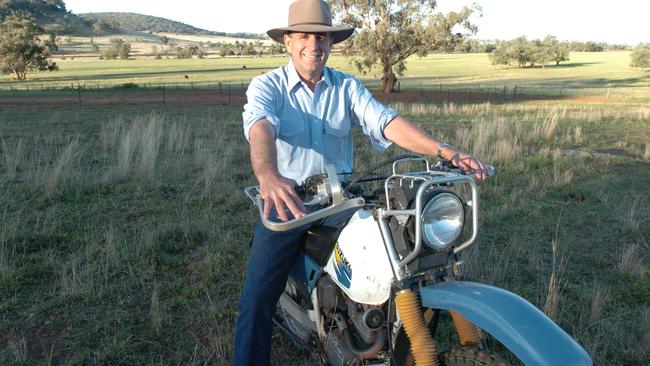From the great Liverpool Plains to the rugby field
Our energy crisis story starts in the Liverpool Plains and moves to the rugby field, but it has a deadly serious edge.

This is one of the strangest stories I have ever written. But it has a deadly serious edge because, potentially, tens of thousands of jobs, including those at Port Kembla steel, could be threatened if the events of 2011-13 are repeated.
Our story starts in the great Liverpool Plains agricultural region of NSW and then transfers to the rugby field at The King’s School in the 1970s. At King’s, the bonding and clashes have played a remarkable role in Australia’s current energy problems.
On the Liverpool Plains there are many longstanding farming families. They include the Bishops and the Andersons. In the 70s they both sent a son to board at The King’s School, Parramatta. John Anderson was a somewhat reserved child who had been affected by his involvement in the accidental death of his sister. Jamie Bishop was a fine rugby player. The senior English master at King’s in the first half of the 1970s was a man named Alan Jones, who also coached the first XV rugby union side. Ex-students still remember Jones taking young John Anderson aside on the field and giving him the most withering blast. Anderson never forgot that, especially as it took place around the time of his sister’s death. Former students say that, thereafter, Anderson stayed well away from Jones.
Jamie Bishop had the reverse experience. In 1974 he was school captain and the captain of the first XV and a hero for Jones, as King’s won the 1974 Greater Public Schools premiership.
Jones left King’s in 1975 and nine years later he became coach of the Australian rugby union team, the Wallabies, and later emerged as the most powerful radio commentator in the country.
Jamie Bishop went back to the family farm on the Liverpool Plains. John Anderson recovered from those events on the rugby field and became deputy prime minister of Australia.
And there it might have ended but for a fateful decision by John Anderson. He stepped down from politics in 2007 and, like Jamie, planned to help operate the family farm. But he was fascinated by a small listed local energy company called Eastern Star Gas, which had reserves and exploration rights to coal seam gas near Narrabri plus a power generation plant. He became chairman and during that time locals tell me that what he was really interested in was converting Eastern Star Gas to liquids, which was a possibility in the then very high oil price period. Unlike today’s leaders, Anderson was concerned that Australian national security was threatened by insufficient petroleum liquids production. But Eastern Star also built up its reserves of gas and was a pioneer in extracting coal seam gas without fracking using lateral drilling techniques. Most of the Eastern Star Gas was on state- owned forest land but some gas was under farmlands. One of the plans was to put a pipeline underground across the Bishop family’s farm and other properties on Liverpool Plains.
The Greens, Jamie Bishop and Alan Jones then mounted the most withering campaign, not just against Eastern Star Gas and the development but also personally against John Anderson (he was only a small share owner of Eastern Star).
There is no doubt that Jones, Bishop and the Greens were genuinely opposed to the development and the pipeline but to former students of King’s, it was the rugby field all over again. Naturally, Alan Jones will say the rugby field didn’t play any role in his attitude, but Jamie Bishop was on the Jones breakfast program regularly and the personal attacks on Anderson reminded ex-students of the rugby field of the 1970s.
In 2011 Santos bought Eastern Star Gas for a massive $920 million but all payable in Santos shares, which were then above $13. They are now around $3.74. The campaign against Eastern Star and Anderson was continued against Santos. The NSW Labor government at the time went to water under the onslaught and later so did the Coalition’s Barry O’Farrell when he came to power.
As a result the Eastern Star/Santos Narrabri gas was never developed. Frankly, as long as Jamie Bishop, his powerful rugby coach and the Greens oppose it, it will be very difficult to get Narrabri off the ground.
But since the Eastern Star takeover in 2011, Santos has gone on to participate in a consortium to develop coal gas via fracking in Queensland as part of an LNG export plant in Gladstone. Unfortunately, the Santos consortium sold much more gas than they had and as a result has to buy gas from the Cooper Basin and Bass Strait, forcing up the price and threatening shortages for Sydney and Melbourne.
Australia will probably get through the coming winter without gas shortages but almost certainly without government action will have shortages in the winters of 2018 and 2019.
Narrabri is a huge gas deposit which is capable of supplying half NSW’s needs. The need for Narrabri has become more urgent than in the early part of the decade because development of the enormous gas reserves in Victoria have been blocked by its premier.
The federal government is now seriously looking at stopping so much gas being sucked north, perhaps by limiting exports by the Santos consortium. If Santos exports take the full hit then the losses might make it very difficult to fund the development of Narrabri. The other Gladstone exporters, the Origin and Shell consortiums, have sufficient gas, but may be forced to share the pain if the shortages in Sydney and Melbourne eventuate.
But amid of the current gas crisis, Santos is now having another attempt to get environmental approval to develop Narrabri. Very sensibly it has developed a pipeline route that stays well away from the Bishops’ farm and connects up with the Moomba/Sydney gas pipeline. Will the King’s duo plus the Greens fight the new Narrabri development? The Greens are already in full action mode.
I often find myself agreeing with Alan Jones, but not always. He is a great defender of Australian farming and is one of the few powerful farmers’ friends. He has my full support.
He is also opposed to any form of fracking. I think fracking is OK but I don’t know the detail and he would beat me in an argument. But because of the work of John Anderson, this Narrabri development does not involve fracking. Modern water management technology makes it one if the safest we can have.
In fairness to Jones and Bishop, back in 2011-13 the Queensland and Victoria messes were not known and Port Kembla and the tens and thousands of NSW jobs were not in jeopardy. But this time they are. As it is, Narrabri will not be developed in time to avoid the likely shortages in 2018 and 2019. But if it is coming it might be possible to minimise the damage.
Four decades and more since the events on the rugby field is a long time. I hope that in 2017 Alan Jones and the Bishop family this time think of those jobs that are now at risk if we don’t have Narrabri gas.




To join the conversation, please log in. Don't have an account? Register
Join the conversation, you are commenting as Logout